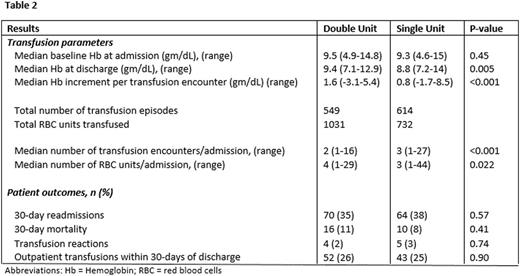Abstract

Introduction
Blood products are a valuable resource associated with infectious and immunological adverse effects, hence the ongoing efforts for blood conservation. Evidence supports the use of restrictive Hemoglobin (Hb) triggers as safe and effective. Nevertheless, transfusion practice remains based largely on physician preference. The use of single-unit (SU) rather than double-unit (DU) transfusions per transfusion episode may be another strategy. Scant retrospective data from the 1960's discarded this idea as being ineffective in treating anemia.A recent European study demonstrated that using a SU transfusion protocol led to a 25% reduction in red blood cell usage amongst patients with hematologic malignancies(Berger et al; Haematologica, 2012). There have been no comparative studies done in the US population outside the orthopedic population which yielded similar benefit (Ma et al; Transfusion Medicine, 2005).
Clinical Decision Support Systems (CDSS) are protocols shown to be effective in standardizing practice. At our academic institution, a CDSS was initiated for admissions to the Malignant Hematology and Transplantation Service. From September 2014, a protocol amendment prompted providers to order SU red blood cells (RBCs) for transfusion for Hb <8. Herein, we report the adherence to CDSS, and the differences in RBC utilization and patient outcomes one year before (DU-gp) and one year after (SU-gp) implementation of this protocol.
Methods
Retrospective chart review was performed on all adult patients admitted to the Malignant Hematology and Transplantation Service who received routine RBC transfusions from 9/1/2013- 8/31/2014 (DU-gp) and 9/1/2014 to 8/31/2015 (SU-gp). Patients with active bleeding were excluded. The primary endpoint for this study was median RBC units transfused per admission. Analysis was limited to RBC products only. Chi-square test and t-test were used in the data analysis for categorical variables and continuous variables, respectively. A mixed model was used for repeated measurements.
Results
147 patients in 201 admissions in DU-gp and 126 patients in 170 admissions in SU-gp were analyzed. Baseline characteristics are presented in Table 1 with no significant differences noted between groups. Excellent adherence to the CDSS protocol was noted in both the DU (97%) and SU (92%) groups. Baseline admission Hb was similar, but Hb at discharge was significantly higher in DU-gp 9.4 g/dL vs 8.8 g/dL in SU-gp (P=0.005).
The median number of transfusion episodes (each time RBC orders were placed) per admission in the DU-gp and SU-gp was 2 (range, 1-16) and 3 (range, 1-27), respectively (P<0.001). The corresponding median number of RBC units given per admission was 4 (range, 1-29) and 3 (range, 1-44), respectively (P=0.02). Overall, a 29% reduction in RBC utilization was noted in SU-gp (731 units) compared to DU-gp (1031 units). No difference was noted in 30-day mortality and readmissions, outpatient transfusion requirements or transfusion reactions between the 2 groups (Table 2).
Conclusions
Our data show that implementing a CDSS, transfusing single-unit RBCs instead of double-units for Hb < 8g/dL had an excellent adherence, highlighting the feasibility of such a strategy. It is noteworthy that although patients required more transfusion encounters, the overall RBC utilization fell by 29%. Single-unit RBC transfusion was safe, efficacious and significantly reduced the RBC utilization per admission. Prospective data is required to confirm our results as well as assess the potential cost-benefit advantage with single-unit RBC transfusions.
No relevant conflicts of interest to declare.
Author notes
Asterisk with author names denotes non-ASH members.

This icon denotes a clinically relevant abstract



